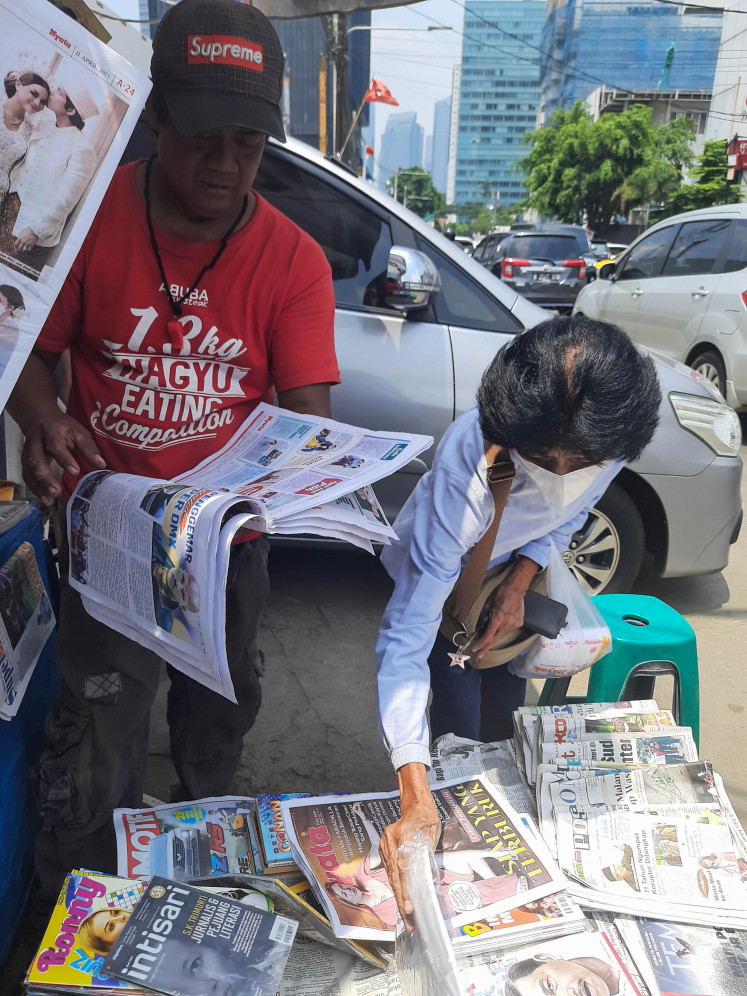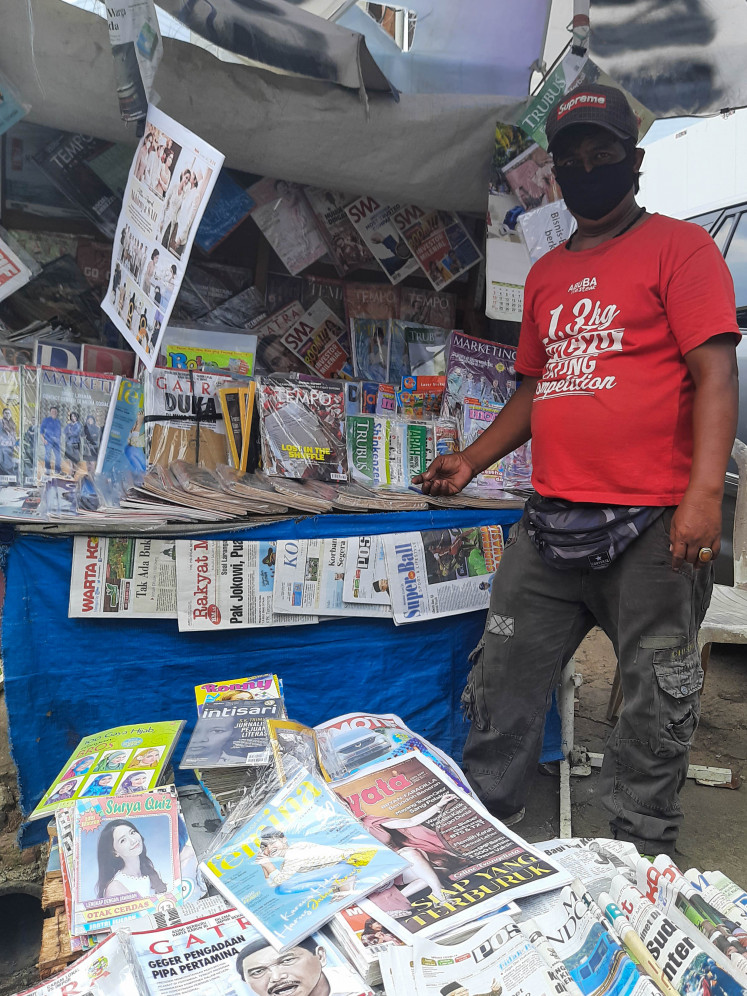Popular Reads
Top Results
Can't find what you're looking for?
View all search resultsPopular Reads
Top Results
Can't find what you're looking for?
View all search resultsSelling newspapers in the digital era: A story of two lifers
Kadum and Iwan entered the newspaper business for survival. They stayed because of love.
Change text size
Gift Premium Articles
to Anyone
I
was on my way home after having breakfast in my neighborhood when I came upon a newspaper delivery man. He was in his 60s with apparent wrinkles and grey hair on his head. He was also wearing a vest with Sinar Harapan written on it, one of the oldest newspapers in Indonesia, which stopped printing more than five years ago.
He was sitting on a side road chatting casually with other street vendors, with a rusty bicycle parked near him that held a pile of newspapers. It was around 11 a.m., and I happened to be looking for the day's edition of The Jakarta Post. I asked if he still had one.
"There are no copies of The Jakarta Post left. I’ve delivered all of them to my customers," he said.
I asked if I could have his phone number in case I wanted to order one someday before he ran out.
"Oh, no. I don't have a phone."
I ended up ordering the newspaper from another seller 5 kilometers from where I live, but I came upon the first vendor some days later, sitting in the exact spot I had seen him before and at the same hour.
I wondered what kind of person it was who, without a phone, still managed to deliver newspapers in the digital era. One day I decided to ask him.
I found out his name was Kadum. Kadum said he was the only newspaper delivery man around Karet, a busy area in central Jakarta.
He starts his days at 4 a.m., riding his bicycle from Bendungan Hilir, Central Jakarta, to Kota, West Jakarta, around 12 kilometers, to purchase newspapers from his agent before going back south to deliver them to his customers around Bendungan Hilir and Pejompongan. At 10 a.m., he rests for a while near Dr. Mintohardjo Naval Hospital, and then continues delivering 11:30 a.m. before returning home.
Born in 1955 in Tegal, Kadum told me he had lived in poverty when he was a child.
"I never ate rice but ate gaplek [dried cassava] instead."
In the 70s, he moved to Jakarta to seek better opportunities. He worked however he could: polishing shoes in Sarinah, carrying goods for vendors at Pasar Mayestik and cleaning dishes in warteg (food stalls). In 1972, he settled on delivering newspapers.
Kadum used to deliver newspapers by foot and would carry them on his shoulders. In 2005, a customer gave him a bicycle. It still works "perfectly", and he remains in contact with the person.
In the era when everyone read newspapers, Kadum had a better living condition. He was able to save money and marry a woman from his hometown. He also bought a house in Tegal, where his wife and his three children live today.
"When newspapers were at their peak in the 70s, I could earn Rp 200,000 per day [US$13.67], much higher than my income working at a warteg, which was only about Rp 150,000 [$10.25] per month."
Iwan is another newspaper vendor in Bendungan Hilir. Unlike Kadum, the 45-year-old owns a stall across from a busy Padang restaurant on the main road of Bendungan Hilir. He is there every day, from day to night, selling newspapers, magazines, comic books and crossword puzzles. He even stocks some international newspapers.
Iwan said he had sold newspapers for most of his life. He started doing so as an elementary school student, delivering newspapers early in the morning before school began at 7 a.m.
In the early 2000s, Iwan said his daily sales could reach Rp 6 million to Rp 7 million ($410 to $478). He was a subagent for newspaper delivery men around Bendungan Hilir and had hundreds of customers. By selling newspapers, Iwan was able to pay for his education, from elementary to high school. He also paid for the education of his four brothers and sisters and was able to provide his ex-wife with a house.
However, when the internet arrived and online media took over, Kadum and Iwan told me their income decreased drastically. These days, Kadum only makes about Rp 1.5 million to 2 million [$103 to $137] monthly. He uses this income to pay for his house in Jakarta, to purchase newspapers from the agent, to send about Rp 1 million [$68.36] to his family and, finally, to meet his own daily needs.
Iwan said the online era had changed everything. "Back then, everyone bought newspapers. It's not like that anymore. If I don't have any customers, it's going to be difficult," Iwan said. "I can still sell newspapers simply because there are no competitors."
Both Iwan and Kadum saw their favorite newspapers stop printing. "I used to religiously read Harian Sentana, Indo Pos and Koran Tempo," Iwan said.
Now, they told me, most of their friends worked as online ojek (motorcycle taxi drivers).
They also have to find ways to make money from the unsold papers. In the early 2000s, when vendors could still sell their goods on public transportation, Kadum would go from one bus to another in the evening to sell his unsold stock at half price. But now, he mainly sells his leftover newspapers in bulk to street vendors, who use them to wrap up food. "So the profit loss will not be too big," he said.
Meanwhile, Iwan keeps his unsold newspapers in his warehouse. A week-to-month-old newspaper can sometimes be sold at a much higher price. "For example, The Jakarta Post newspaper, with a regular price of Rp 7,500 [US$0.51], can be sold at Rp 40,000 [US$2.73], depending on how old it is. People sometimes look for them for documentation. I use the money to cover the loss of other unsold newspapers."
No longer thriving: Iwan stands in front of his newspaper stall. (JP/Permata Adinda)Besides selling newspapers to individuals, Iwan's main customers are now offices, mostly banks. Meanwhile, Kadum's customers are elderly people. "People older than me. I no longer deliver newspapers to people in their 30s or 40s, let alone 20s."
Even though Kadum can now count his customers on one hand, they remain loyal to him and have kept buying newspapers even though they no longer read them.
"In this pandemic era, they seem to be afraid to touch the papers. But they have refused to stop buying even though I have already offered it. Maybe they don't want to make me feel bad."
Iwan and Kadum understand that they could go out of business at any time. Kadum said that if, one day, he had no customers left, he was ready to return to his hometown.
"I will go home to work in the rice fields."
However, despite the struggle, neither Kadum or Iwan has switched to another job. Kadum is proud of his job. "Other people changed jobs when newspapers went downhill, but I didn’t. I feel content selling newspapers."
Iwan said he owed his life to newspapers and would not leave the business. "I will sell newspapers until my last drop of blood."













